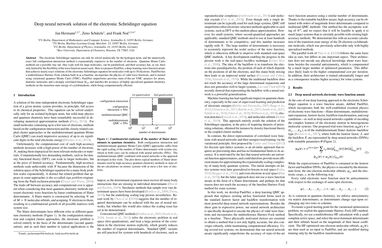Deep-neural-network solution of the electronic Schrödinger equation
The electronic Schrödinger equation can only be solved analytically for the hydrogen atom, and the numerically exact full configuration-interaction method is exponentially expensive in the number of electrons. Quantum Monte Carlo methods are a possible way out: they scale well for large molecules, they can be parallelized and their accuracy has, as yet, been only limited by the flexibility of the wavefunction ansatz used. Here we propose PauliNet, a deep-learning wavefunction ansatz that achieves nearly exact solutions of the electronic Schrödinger equation for molecules with up to 30 electrons. PauliNet has a multireference Hartree–Fock solution built in as a baseline, incorporates the physics of valid wavefunctions and is trained using variational quantum Monte Carlo. PauliNet outperforms previous state-of-the-art variational ansatzes for atoms, diatomic molecules and a strongly correlated linear H10, and matches the accuracy of highly specialized quantum chemistry methods on the transition-state energy of cyclobutadiene, while being computationally efficient.
PDF Abstract

